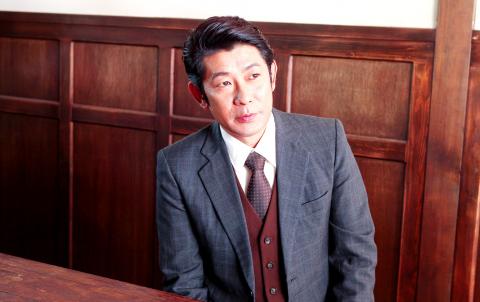Readers familiar with cult American films might remember Jim Jarmusch’s 1989 movie Mystery Train, which not only put the director on the world map but also turned the then-22-year-old Japanese actor Masatoshi Nagase — a high school drop-out from the countryside — into a star.
Fast forward to 2013 and Nagase is in Taiwan as part of the cast of Kano, a baseball drama about a 1931 Chiayi high school team. The film, backed by Wei Te-sheng (魏德聖), is directed by Seediq Bale (賽德克‧巴萊) alumnus Umin Boya.
Filming has been going on in five cities around Taiwan since November, from Chiayi to Keelung, and is set to wrap at the end of March.

Photo: Taipei Times
An all-Taiwanese cast comprised of mostly unknown faces, as well as four well-known Japanese actors playing pivotal roles, is bringing the Wei-scripted story to life.
Among the four Japanese actors, Nagase, now 46, has been cast as a strict Japanese high school baseball coach. During a recent press conference in Chiayi, Nagase said he was enjoying his time in Taiwan, even posting photos of various Taiwan scenic locations on his Facebook page.
big budget flick
Nagase told reporters at the conference in Chiayi that he was impressed by the Hollywood-style set that has been built in Chiayi, confessing: “A movie set of that size is rare even in Japan today.”
When asked by the Taipei Times if Jarmusch was aware of his starring role in Kano, Nagase said in English: “I’m not sure if he knows yet, but I hope he will find out later. I love Jim Jarmusch.”
According to the producers, over NT$50 million has been spent to build a 1931-era set, and there are plans to retain some of the Kano main street set as a tourist attraction before and after the movie opens next year.
a taste of old chiayi
There’s a huge wooden replica of an old Japanese-style Chiayi train station from the 1930s, complete with a bright red Japan Post Office collection box made of cardboard, several fake telephone poles with fake telephone wires strung up in the air, and emergency sand containers used to put out fires in the Japanese colonial period days before fire trucks and fire hydrants were put into service here.
The three other actors from Japan cast in the film are Takao Ozawa, Maki Sakai and Togo Ikawa.
Putting Nagase in Kano appears to be a stroke of casting genius since Jarmusch is a big name in America and Europe and it is hoped that Nagase’s star turn will bring in Western viewers to the baseball drama — not to mention his many fans in Japan where he has appeared on TV shows, movies and in an assortment of popular and often humorous TV commercials over the past 20 years.

Most heroes are remembered for the battles they fought. Taiwan’s Black Bat Squadron is remembered for flying into Chinese airspace 838 times between 1953 and 1967, and for the 148 men whose sacrifice bought the intelligence that kept Taiwan secure. Two-thirds of the squadron died carrying out missions most people wouldn’t learn about for another 40 years. The squadron lost 15 aircraft and 148 crew members over those 14 years, making it the deadliest unit in Taiwan’s military history by casualty rate. They flew at night, often at low altitudes, straight into some of the most heavily defended airspace in Asia.

Beijing’s ironic, abusive tantrums aimed at Japan since Japanese Prime Minister Sanae Takaichi publicly stated that a Taiwan contingency would be an existential crisis for Japan, have revealed for all the world to see that the People’s Republic of China (PRC) lusts after Okinawa. We all owe Takaichi a debt of thanks for getting the PRC to make that public. The PRC and its netizens, taking their cue from the Chinese Communist Party (CCP), are presenting Okinawa by mirroring the claims about Taiwan. Official PRC propaganda organs began to wax lyrical about Okinawa’s “unsettled status” beginning last month. A Global

Taiwan’s democracy is at risk. Be very alarmed. This is not a drill. The current constitutional crisis progressed slowly, then suddenly. Political tensions, partisan hostility and emotions are all running high right when cool heads and calm negotiation are most needed. Oxford defines brinkmanship as: “The art or practice of pursuing a dangerous policy to the limits of safety before stopping, especially in politics.” It says the term comes from a quote from a 1956 Cold War interview with then-American Secretary of State John Foster Dulles, when he said: ‘The ability to get to the verge without getting into the war is

Like much in the world today, theater has experienced major disruptions over the six years since COVID-19. The pandemic, the war in Ukraine and social media have created a new normal of geopolitical and information uncertainty, and the performing arts are not immune to these effects. “Ten years ago people wanted to come to the theater to engage with important issues, but now the Internet allows them to engage with those issues powerfully and immediately,” said Faith Tan, programming director of the Esplanade in Singapore, speaking last week in Japan. “One reaction to unpredictability has been a renewed emphasis on